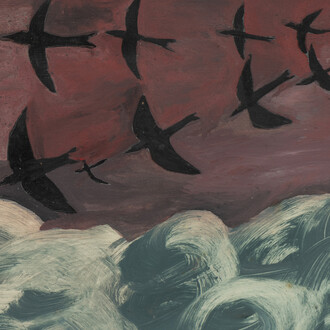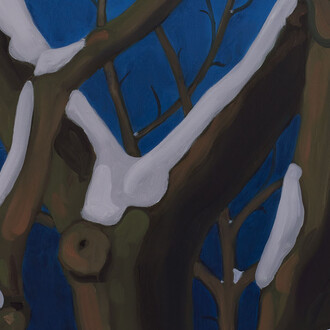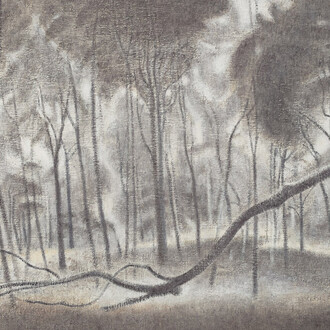NHG’s summer show, Clay, opens on June 19 and continues till September 3. Included in the exhibition are works by: Joan Bankemper, Judy Fox, Viola Frey, Tony Marsh and Jesse Small.
Use of clay or pottery is the oldest handicraft in existence, and, thus, its long history. In prehistoric times, water was likely carried in woven baskets lined with river clay. After the water was poured out of the container the layer of clay dried. The loss of moisture caused the shape to shrink and separate from the sides of the basket. When the clay, now shaped like a pot, was removed, and dried in the sun on hot sand, it retained the basket pattern. It was then discovered that the clay would harden in hot ashes, and could be made into containers to transport and store food. From approximately 400 BC earthenware pottery was produced on a potter’s wheel in many parts of the world. The Egyptians made kilns to fire their clay pots. The Greeks made pots decorated with pictures of their daily lives and stories of their gods and heroes, painted in black on naturally colored red clay. Traditions in clay continued to evolve through medieval times to the present with China being the first country to work in porcelain.
Joan Bankemper’s ceramic mosaics follow her love of nature and the change of seasons. Each piece is a garden. Her primary focus is on bees and flowers, which she forms into mandalas of nature. Bankemper begins with a simple glass vase at the core or a hand- built vessel of clay. Casting from a collection of 1500 molds, the artist creates myriad shapes and sizes, animals and figurines, combining these with historical ceramics, contemporary china, and 100’s of hand-built objects. Everywhere the eye looks, there is something rich, textured and layered for the eye to behold. Bankemper’s clay and porcelain sculptures are a contemporary manifestation of “horror vacui.”
Judy Fox pioneered painted figuration in the 1980's, transposing iconic images from various cultures into finely rendered figures with period coiffures, created in terra cotta, painted in many layers of casein paint. Her recent exhibition “Garden” germinates from the biblical Genesis story. In Eden, a Serpent tempts Eve to taste fruit from the forbidden tree, a transgression she shares with Adam. Created in terra cotta, painted in many layers of casein paint, this scenario, comprises five years of the artist’s work. Eve is the central figure. She is posed after the famous Lucas Cranach version, a pale beauty with waves of blond hair who coyly hides an apple behind her back. Her inquisitive eye is caught by a surrealist Snake Tree with a visceral sensuality and an apple-red face. Eve is surrounded by a multitude of highly colored imagined Eden plants, which combine plant-like sensual components to complete the tableau.
Viola Frey loved the human figure; she also loved color. Her palette was oranges, reds, blues and pinks. She was most well known for her monumental standing men, up to 11 feet in height, often dressed in blue power suits, wearing red ties; and her seated women usually wear pink birthday suits. Every few years Frey would work on a body of heraldic tondos filled with her iconographical images: faces, hands, commedia dell’arte masks, figurines, horses, among other imagery. Dating from 1978 to the early 2000s, the plates evolve from flat tondos to sculptural, bas relief works with rich and juicy color. Her “bricolage” groupings of figures, figurines, cast objects, slip cast from her flea market finds, were for the artist a statement about contemporary society, abstractions of the world around her. In these bricolage pieces she included references to art history, religions of the world, pop culture, every man, every woman. Frey has been called one of the great artists of the 20th century.
Tony Marsh writes of his Crucible series: “Over the past ten years of developing my Crucible series my approach to working with clay and glaze materials has undergone both a philosophical and a methodological realignment. At present, I am moving increasingly further away from the traditional approaches to working with clay that were foundational to my education; namely, the dogmatic tendency of craftsmanship to seek predictability and reproduce results. Instead, I favor chance and the unknowable result. When I open a kiln, I am seeking something I have never seen. With successive firings Marsh pushes the boundary between material destruction and creative renewal, by layering mineral concoctions on the surface. About his choice of form, Marsh writes: “The elemental has always interested me. Simple straight walled cylinders of differing proportions have been a constant in this ongoing body of work and it is the unique application of glaze materials and firing practice that provides the variables that give life to each work.”
Jesse Small On Jesse Small’s first sojourn in China, he set up a ceramics studio in Jingdezhen. He travels between his California studio and China periodically to create his porcelain pieces, utilizing historic resources of Jingdezhen and inspiration from Chinese culture. Some of his pieces are finished in China, most are started there, and ultimately finished in Los Angeles. Each piece is a unique result of multi layered glazing methods, with dozens of firings on a single piece.
Small writes about his “ghost” sculptures: “I started making the porcelain ghost sculptures in Jingdezhen, China, inspired by the popularity of ghost-defense items there. The neighborhood I was working in mass produced porcelain figurines of all sizes, whose purpose was to ward off ghosts. Conceptually, I wanted to create a "ghost figurine" that would welcome, instead of ward off, and give form to something invisible. But how to make a ghost-shaped figurine? While I was developing the form, I used my memories of the Pac-Man video game "ghost" characters, which form the overall shape of these sculptures. I found a visual language that is loosed from culturally specific references, i.e., video game--a global language.” Through June NHG will be open Tuesday through Saturday from 10-6. In July and August the gallery will be open Monday through Friday from 10-5.
















